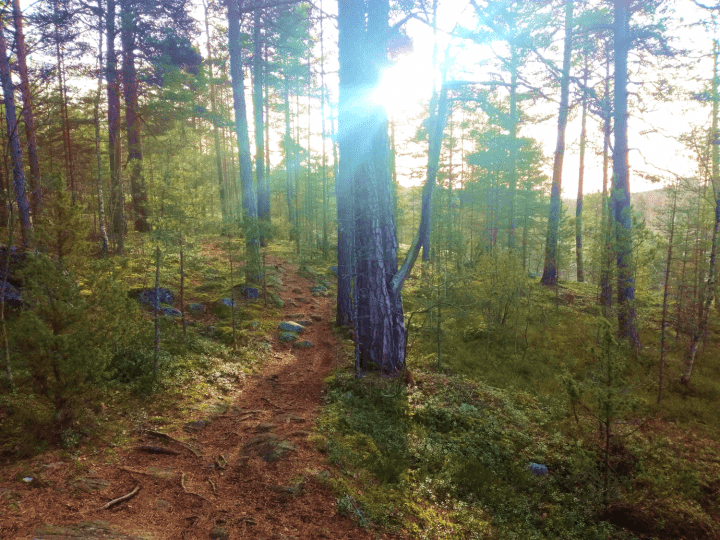Lockdown highlights the importance of green spaces and nature to human wellbeing in cities
Nora Fagerholm & Salla Eilola, Department of Geography and Geology, University of Turku
COVID-19 has suddenly forced us to social distancing in order to prevent spreading the virus. Societal lockdown and changes in everyday practices are prevalent in the lives of most of us. A side effect of social distancing is increased boredom, frustration and anxiety (Brooks et al., 2020). The strictness of regulations has been varying between countries. In Finland, residents can freely go outdoors, typically with family members. Gatherings of more than ten persons are prohibited in public spaces. In these times, urban green areas can be more important than ever. This applies to nearby green but also, popular national parks close to cities have experienced crowding in the past weeks. In fact, Google mobility data shows 56% increase in visits to parks in Finland (Google, 2020).
Scientific evidence shows that nature does good for us. Research across a wide spectrum of disciplines has empirically explored the linkages between nature or ecosystems and human wellbeing with the conclusion that nature generally makes people happier and healthier (both physically and mentally) (e.g. Hartig et al., 2014; Kondo et al., 2019; Russell et al., 2013). In the time of the COVID-19 but also during any future crises that are likely to be caused, for example, by climate change, it is important to ensure access to nature due to its positive effects on our wellbeing while at the same time allowing social distancing for urban dwellers.
Our interest is to study outdoor activities, and perceived meanings and wellbeing effects of nature in the city of Turku, among citizens from various backgrounds. Are there features in the urban green that particularly appeal to certain social groups and how could planning ensure these features exist in our urban environment? While the large-scale mobility patterns can be observed through passive sensing technologies including Google tracking or mobile phone data, participatory mapping (public participation GIS, PPGIS) offers a possibility to study the behaviour of individuals and perceptions behind their behaviour in a place-based way. PPGIS has been widely applied to understand how everyday places relate to wellbeing (e.g. Kyttä & Brown, 2014; Fagerholm et al., 2020).
In GreenPlace research project, we study the wellbeing benefits of urban green infrastructure mapped through participation and 3D virtual landscapes (Academy Research Fellow project funded by the Academy of Finland, grant number 321555). COVID-19 further increases the relevance of the project. We study wellbeing benefits of green areas through collecting location-based information on people’s perceptions and preferences. Such knowledge helps strategic green area planning in cities and helps to build resilience in future.
References:
Brown, G., & Kyttä, M. (2014). Key issues and research priorities for public participation GIS (PPGIS): A synthesis based on empirical research. Applied Geography, 46, 126–136. https://doi.org/10.1016/j.apgeog.2013.11.004
Brooks, S. K., Webster, R. K., Smith, L. E., Woodland, L., Wessely, S., Greenberg, N., & Rubin, G. J. (2020). The psychological impact of quarantine and how to reduce it: rapid review of the evidence. The Lancet, 395(10227), 912–920. https://doi.org/10.1016/S0140-6736(20)30460-8
Fagerholm, N., Martín‐López, B., Torralba, M., Oteros‐Rozas, E., Lechner, A.M., Bieling, C., Stahl Olafsson, A., Albert, C., Raymond, C.M., Garcia‐Martin, M., Gulsrud, N. & Plieninger, T. (2020). Perceived contributions of multifunctional landscapes to human well‐being: Evidence from 13 European sites. People and Nature, 2, 217-234. https://doi.org/10.1002/pan3.10067
Google. (2020b). Finland April 26, 2020 Mobility changes. Retrieved from https://www.google.com/covid19/mobility/
Hartig, T., Mitchell, R., de Vries, S., & Frumkin, H. (2014). Nature and health. Annual Review of Public Health, 35(1), 207–228. https://doi.org/10.1146/annurev-publhealth-032013-182443
Kondo, M. C., Fluehr, J. M., McKeon, T., & Branas, C. C. (2018). Urban green space and its impact on human health. International Journal of Environmental Research and Public Health, 15(3). https://doi.org/10.3390/ijerph15030445
Russell, R., Guerry, A. D., Balvanera, P., Gould, R. K., Basurto, X., Chan, K. M. A., … Tam, J. (2013). Humans and nature: How knowing and experiencing nature affect well-being. Annual Review of Environment and Resources, 38(1), 473–502. https://doi.org/10.1146/annurev-environ-012312-110838
